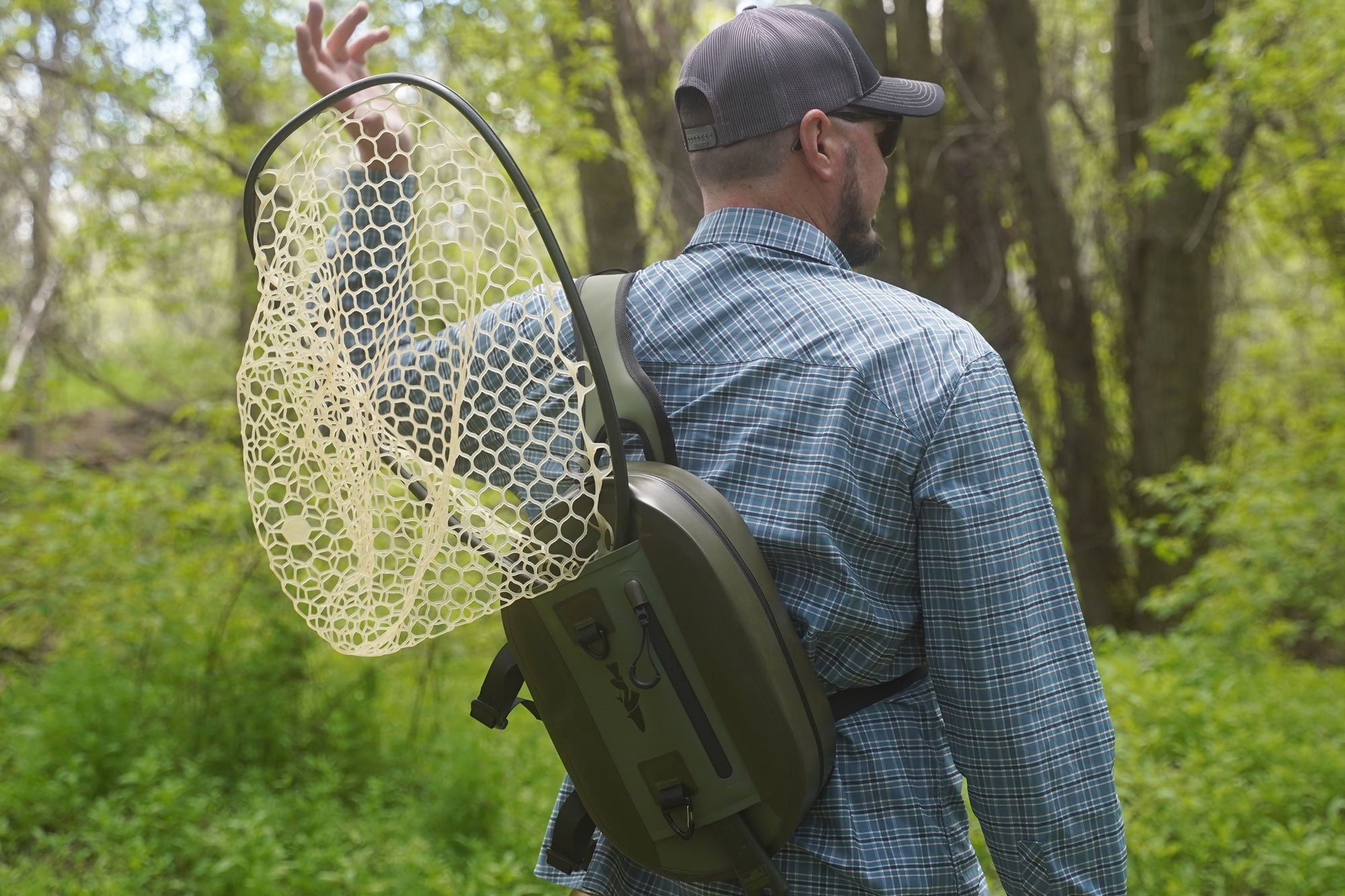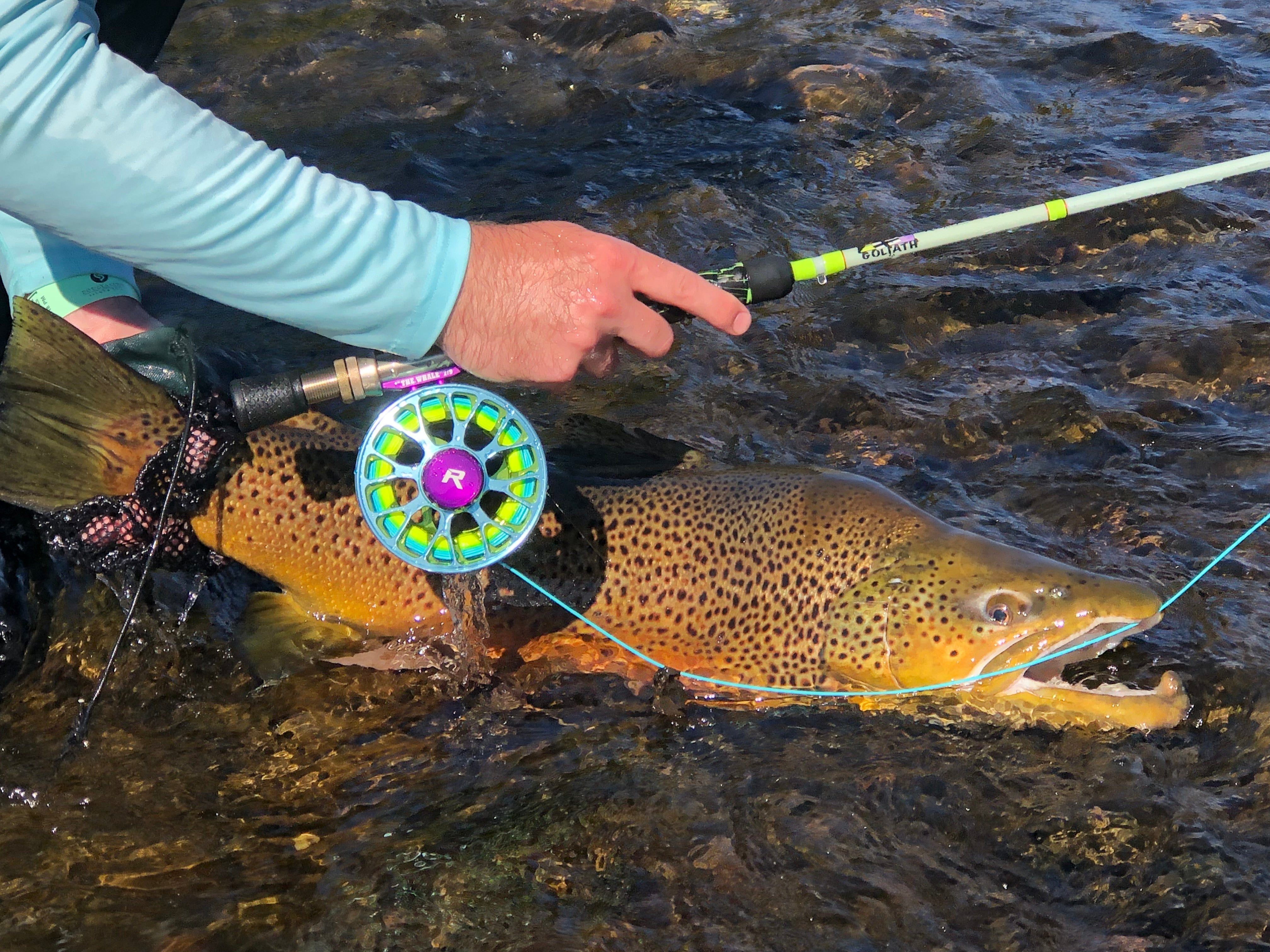Quick Stats
- Difficulty: Beginner to Intermediate
- Best Season: April - October
- Target Species: Brown, Rainbow, and Cutthroat Trout
- River Miles: 65+ miles of fishable water
- Average Fish Count: 800-1,200 trout per mile
- License Required: Utah fishing license (age 12+)
Why the Weber River Should Be Your Next Destination
There's something special about stepping into the Weber River that hits you immediately—the clarity of the water, the backdrop of the Wasatch Mountains, and the knowledge that you're fishing one of Utah's most productive yet underrated trout streams. As someone who's spent countless hours exploring waters across the Intermountain West for the Fly Fishing Insider Podcast, I can tell you that the Weber consistently surprises me with its diversity and fish populations.
The Weber River begins in the Uinta Mountains at the base of the Bald Mountain, Notch Mountain and Mount Watson, and what makes this river truly special is its journey. The Weber enters Rockport Lake then turns north picking up the tributaries of Silver Creek and Chalk Creek, before it flows into the Echo Reservoir. The Middle Weber winds 13 miles through farmland paralleling Interstate 80 and empties into Echo Reservoir.
What really sets the Weber apart is its accessibility combined with its productivity. While a majority of the Weber is private property, the Utah Department of Wildlife Resources has created innovative solutions that open up some fantastic fishing opportunities. This isn't just another crowded tailwater—this is legitimate fishing with wild trout that will test your skills and reward your patience.

Access Points & River Navigation
The Weber's Three Distinct Sections
The Weber River offers three distinct fishing experiences, each with its own character and access considerations.
Upper Weber (Headwaters to Rockport Reservoir)
-
Rockport State Park - Easy access point with parking
- GPS: 40.8644° N, 111.3160° W
- Parking: Day-use fee required ($10)
- Facilities: Restrooms, picnic areas, boat ramp
- River Character: Grayling, brook, brown, rainbow and cutthroat trout all share the bountiful pools, runs and riffles
Middle Weber (Rockport Dam to Echo Reservoir) This is where the Weber really shines for most anglers. Public recreational access in the Weber River begins at the confluence of the Middle and Main Forks and extends downstream to Echo Reservoir.
-
Rockport Dam Access - Mile 0
- GPS: 40.8547° N, 111.3142° W
- Parking: Roadside parking available
- Facilities: None
- The middle Weber starts below the spillway at Rockport Reservoir and flows all the way down to Echo Reservoir. The nice part about this portion of the Weber is it was recently deems navigable and as long as you are in the stream bed, you have legal access.
-
I-80 Bridges - Various access points
- Multiple bridge crossings provide access
- Park safely off I-80 and walk to river
- Caution: Be extremely careful of highway traffic
-
Echo Reservoir Access - Mile 13
- GPS: 40.9394° N, 111.4153° W
- Facilities: Boat ramp, parking
Access Program Information
The Utah Department of Wildlife Resources and property owners have developed a very accessible solution — the "Walk In Access Program" (WIA). Given that much of the Weber flows through private land, access is granted through the Division of Wildlife Resources' Walk-In Access (WIA) Program.
Floating Information
- Total Fishable Miles: 65+ miles across all sections
- Middle Weber Float: 13 miles, 4-6 hours
- Recommended Watercraft: Drift boat, raft, or kayak for middle section; walk-and-wade for upper sections
- Shuttle Services: Contact local fly shops for arrangements

Fish Population & Species
Primary Species
Brown Trout
- Average Count: 400-600 fish per mile
- Size Range: 10"-16" typical, 20"+ trophy potential
- Best Locations: Deeper pools in middle Weber, undercut banks
- Peak Activity: Early morning and evening, especially fall
Rainbow Trout
- Average Count: 300-400 fish per mile
- Size Range: 8"-14" typical, occasional 16"+ fish
- Best Locations: Riffles and runs throughout middle section
- Peak Activity: Midday during hatches, responsive to nymphs
Cutthroat Trout
- Average Count: 100-200 fish per mile
- Size Range: 12"-18" typical
- Best Locations: The Weber is home to rainbows, browns and cutthroat trout, in addition to whitefish, brookies and even graylings near the headwaters
- Peak Activity: Morning and evening in deeper water
Additional Species
The upper Weber near the headwaters offers unique opportunities for whitefish, brookies and even graylings, making it one of the few places in Utah where you can target Arctic grayling.
What to Expect
The Weber maintains a medium sized river that provides some great trout fishing with healthy populations averaging 800-1,200 trout per mile in the prime middle section. During my most recent podcast research trip, we consistently found active fish in every run we tested, with the surprising bonus of larger-than-expected brown trout holding in the deeper pools near bridge structures.
Seasonal Guide & Hatch Charts
Spring (March - May)
Water Conditions: High flows from snowmelt, clearing by late April Target Species: All species active, browns moving for spawning preparation Key Hatches:
- Blue-winged olives that hatch from March through mid May - BWO #16-20
- March Browns hatch from April into middle June - March Brown #12-14
- Little Black Caddis (Mother's Day Grannoms) hatch from late April into July - Black Caddis #14-16
Summer (June - August)
Water Conditions: Lower, clearer flows, excellent visibility Target Species: All species feeding actively on surface during hatches Key Hatches:
- PMD 12-16 June 1 August 31 - Pale Morning Duns
- Quill Gordons hatching from mid May into June - #14-16
- Yellow Sally 14-16 June 1 August 31 - Golden Stonefly
- Caddis 12-14 May 1 October 31 - Various caddis species
Fall (September - November)
Water Conditions: Stable flows, excellent fishing conditions Target Species: Brown trout become aggressive pre-spawn Key Hatches:
- BWO 18-22 September 1 November 30 - Blue Winged Olives
- Mahogany dun, BWOs, October caddis and Spotted sedge caddis hatches
- Terrestrials: Ants, beetles, hoppers
Winter (December - February)
Water Conditions: The Weber can be fished year-round, with the exception of the upper Weber, which can see a lot of snowfall during winter, making access challenging Target Species: Focus on middle Weber browns in deeper pools Techniques: Midges, small nymphs, patience required
[INSERT HATCH CHART: Comprehensive monthly calendar showing BWO (Mar-May, Sep-Nov), PMD (Jun-Aug), March Browns (Apr-Jun), Caddis (May-Oct)]
Local Fly Patterns & Proven Techniques
Essential Fly Patterns
Dry Flies:
- BWO Comparadun - Size #16-20 - Fish a BWO olive when blue wing olives are hatching
- PMD Sparkle Dun - Size #14-16 - Critical during summer PMD hatches
- Elk Hair Caddis - Size #14-16 - Year-round producer for caddis activity
- Parachute Adams - Size #14-18 - Reliable all-season attractor
Nymphs:
- Spanish Bullet - Size #16-18 - Try a spanish bullet, copper johns, Baetis nymphs and rainbow warriors during the day
- Copper John - Size #14-18 - Proven Weber producer
- Rainbow Warrior - Size #16-20 - Excellent for rainbows
- Pheasant Tail Nymph - Size #14-18 - Match-the-hatch standard
Streamers:
- Woolly Bugger - Size #8-12 - Black, olive, brown variations
- Zonker - Size #6-10 - Effective for larger browns
- Sculpin patterns - Size #6-8 - Match native baitfish
Techniques That Produce
High-Stick Nymphing This technique absolutely dominates on the Weber, particularly in the pocket water and runs of the middle section. I've found that using a 10-foot 4-weight with a 12-foot leader and split shot positioned 18 inches above your flies produces consistent results. Flows are low so be careful not to spook fish.
Dry Fly Presentations The Weber's riffles and glides are perfect for classic upstream presentations. During good numbers of midges and caddis, with ample Mayfly species such as pale morning dun and baetis hatches, focus on drag-free drifts in the feeding lanes.
Evening Techniques Try soft hackles and klinkhammers in the evening when fish become more aggressive. The transition periods at dusk often produce the Weber's best surface action.
Gear Recommendations
Rod Selection
- Primary: 9' 4-weight - Perfect for the Weber's medium-sized water and typical fish
- Alternative: 9' 5-weight - Better for windy days and streamer fishing
- Upper Weber: 8'6" 3-weight - Ideal for the smaller upper sections and grayling
Reel & Line
- Reel: Mid-arbor reel with smooth drag - Fish fight hard on the Weber
- Line: Weight-forward floating line - Covers 90% of Weber fishing
- Leaders/Tippets: 9-12' tapered leaders, 4X-6X tippet
Essential Tackle
- Strike Indicators: Yarn or foam - Essential for nymph fishing
- Split Shot: Varied weights - Adjust to water depth and flow
- Fly Boxes: Organize by season and hatch - Weber has diverse insect life
- Forceps: For easy hook removal - Practice catch and release
Waders & Accessories
- Waders: Breathable chest waders - Water can be deep in spots
- Boots: Felt or rubber soles with studs - Rocky bottom requires good traction
- Net: Medium-sized rubber net - Easier on fish for release
- Polarized Sunglasses: Essential for spotting fish in clear water
Stories from the Stream
The Day I Learned to Read Weber Water
Last October, I was filming content for the podcast on a particularly challenging section of the middle Weber. The water looked perfect—good flow, plenty of structure—but after two hours, I hadn't touched a fish. Frustrating doesn't begin to describe it, especially when you're trying to demonstrate techniques on camera.
Then I met Tom, a local angler who'd been watching me struggle. Instead of pointing out what I was doing wrong, he simply asked, "What do you see when you look at that water?" I described the obvious—the riffle, the deeper run, the undercut bank. He nodded and said, "Now look for the seams."
That single word changed everything. Tom showed me how the Weber's complex currents create subtle seams and feeding lanes that aren't immediately obvious. Within minutes of adjusting my presentation to fish these micro-currents, I was into a beautiful 15-inch brown. The lesson wasn't just about technique—it was about truly observing the water and understanding that the Weber rewards patience and precision over brute force.
The Grayling Quest
One of my most memorable Weber experiences happened while researching the upper section for a podcast episode about Utah's unique fish species. The Weber is home to rainbows, browns and cutthroat trout, in addition to whitefish, brookies and even graylings near the headwaters, and I was determined to document grayling on camera.
After hiking into a remote section above Rockport, I spent the better part of a day carefully working small dry flies through the crystal-clear pools. Just as I was starting to doubt the reports, a distinctive dorsal fin broke the surface—unmistakably a grayling. The fight was unlike anything else: part trout, part sailfish, with aerial displays that left me speechless.
That grayling reminded me why I love exploring waters like the Weber. It's not just about the numbers or even the size of the fish—it's about those moments when you connect with something truly special, something that makes you remember why you started fly fishing in the first place.
Local Resources & Fly Shops
Jans Fly Shop (Park City)
- Address: 1600 Park Avenue, Park City, UT 84060
- Phone: (435) 649-4949
- Website: jans.com
- Specialties: Weber River guide services, local fly patterns
- Services: Half day and full day guided trips, current conditions reports
- Why Visit: Jans has been the go-to Weber River resource for decades. Their guides know every pool and riffle, and they stock all the local patterns mentioned in this guide. Their proximity to Park City makes them perfect for combining a skiing trip with some winter Weber fishing.
Western Rivers Flyfishing (Salt Lake City)
- Address: Multiple locations in Salt Lake Valley
- Phone: (801) 521-6424
- Website: westernriversflyfishing.com
- Specialties: Weber River guide services and local knowledge
- Services: Full-service fly shop, guided trips, fly tying classes
- Why Visit: Their current conditions reports are invaluable: "Be on the lookout for fish up and eating along the rivers edges on Yellow Stonefly dries and nymphs, Pale Morning Dun (P.M.D.) mayfly dries and nymphs (#16-#18), Caddis dries and emergers (#14-#16)"
Pro Tip: Both shops carry the Weber-specific patterns mentioned in this guide and provide real-time conditions reports. Mention you heard about them on the Fly Fishing Insider Podcast!
Licensing & Regulations
Required Licenses
- Utah Fishing License - Required for ages 12 and older - In Utah, everyone under the age of 12 can fish for free! If you're 12 or older, a license is required, easy to obtain and affordable
- Resident Annual: $34
- Non-resident Annual: $55
- Short-term options available: 1-day, 7-day licenses
Weber River Specific Regulations
The Weber River has some unique access rules due to recent court decisions. In November 2017, the Utah Supreme Court issued a decision in Utah Stream Access Coalition v. Orange Street Development. That decision modified the rules related to public recreational access along a segment of the Weber River in Summit County.
Key Points:
- Access corridor width — Recreational access is limited to the bed of the Weber River within the ordinary highwater mark
- Stay within the stream bed when on private property sections
- Respect private property boundaries
- Check river access regulations for the specific area you plan to fish, be respectful of private land, and as always, practice good river etiquette
General Utah Fishing Rules
- Bag Limits: 4 trout daily, 8 in possession
- Size Restrictions: No minimum size restrictions on most Weber sections
- Methods: Artificial flies and lures recommended; bait allowed but less effective
- Special Rules: No barbed hooks in some sections (check current regulations)
Conservation Notes
The Weber River benefits from active conservation efforts by Utah DWR and local angling groups. Practice catch and release, especially for larger fish, to maintain the quality fishery. The river's health depends on responsible angling and habitat protection.
Getting There from Salt Lake City
Driving Directions
From Salt Lake City (Approximately 1 hour, 45 miles)
To Middle Weber Access Points:
- Take I-80 East toward Park City for approximately 35 miles
- Exit at various points between Wanship (Exit 156) and Echo Reservoir (Exit 164)
- Bridge access points are visible from the interstate
- Park safely away from traffic and walk to river access
To Rockport Reservoir/Upper Weber:
- Take I-80 East to Exit 156 (Wanship)
- Turn south on Highway 32 toward Kamas
- Continue approximately 6 miles to Rockport State Park
- Day-use fee required for park access
Alternative Routes
Via Park City (Scenic Route):
- Take I-80 East to Park City
- Follow Highway 248 north toward Kamas
- Connect with Highway 32 to Rockport
- Adds 15 minutes but offers better scenery and fly shop stops
What to Expect
The drive from Salt Lake City takes you through some of Utah's most beautiful country. Plan for 45 minutes to an hour to the middle Weber access points, longer for upper sections. The Middle Weber winds 13 miles through farmland paralleling Interstate 80, making access straightforward once you reach the area.
Traffic Note: I-80 can be busy during ski season and summer weekends. Plan accordingly and always park completely off the roadway.
[INSERT LOCATION MAP: Showing routes from Salt Lake City to various Weber River access points]
Lodging & Dining
Accommodation Options
- Rockport State Park Campground - On-site camping near upper Weber - Reservations recommended
- Park City Resorts - 30 minutes from middle Weber - Full-service options
- Echo Lodge - Near Echo Reservoir - Budget-friendly option
- Kamas Area Lodging - Gateway to upper Weber - Several B&B options
Dining Recommendations
- Kamas Cafe - Local favorite for hearty breakfast before fishing - Cash only
- Park City Restaurants - Full selection if staying in town
- Pack Your Own - Many access points are remote; bring lunch and plenty of water
Final Thoughts
The Weber River represents everything I love about Utah fly fishing—diverse water types, healthy fish populations, stunning scenery, and the kind of technical challenges that make you a better angler. Whether you're a beginner looking for easy wading in the middle section or an experienced angler seeking to challenge the most experienced anglers with technical presentations to selective trout, the Weber delivers.
The Weber has most of the common Utah hatches, meaning there's always something happening if you know where to look and when to be there. The combination of character with reliable access makes this a river you'll want to return to throughout the season.
As I always say on the Fly Fishing Insider Podcast, the best river is the one you're fishing right now. But when you're planning your Utah fishing adventure, the Weber River should be at the top of your list. It's a river that rewards study, patience, and technique—exactly the kind of water that makes you fall in love with fly fishing all over again.
Remember: Be respectful of private land, and as always, practice good river etiquette. The Weber's continued access depends on anglers demonstrating responsible behavior and respecting landowner relationships.
Connect & Share
Did this guide help you have a successful trip to the Weber River? I'd love to hear about your experience!
- Email: christian@flyfishinginsider.com
- Podcast: Find the Fly Fishing Insider Podcast on Apple Podcasts, Spotify, and all major platforms
- Social Media: @FlyfishingInsider
Share Your Story: Send photos and stories from your Weber River adventure - you might be featured on a future podcast episode! I'm always looking for listener experiences to share with the Fly Fishing Insider community.
This guide was last updated July 2025. River conditions, regulations, and access can change seasonally and due to legal decisions. Always check current Utah DWR regulations and local fly shop reports before your trip.






